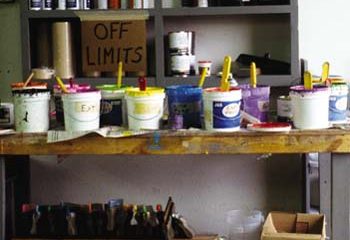The Upside to Downsizing
Published
20 years agoon
It’s rather difficult to maintain a positive attitude about the current state of the high-volume garment-decorating industry in North America when so many larger screen-printing companies are shutting down or moving their production facilities off shore. Too many big shops have closed in recent years, often because the companies would rather shut their doors than scale down and find new markets to serve. The decision could be a result of management’s ego–the top brass equates success with having a large operation. Others may not look to downsizing because they’re unable to identify alternate markets that remain in the US to replace the high-volume business their former corporate clients are now sending abroad.
A garment-printing company that has worked only with large, corporate accounts for years easily can lose sight of the opportunities that remain in smaller, but more stable, domestic market niches. Since the introduction of NAFTA and similar trade agreements, most all of the large corporate textile screen-printing business is now sourced out to third-world countries that offer manufacturing, printing, and packaging at prices that domestic shops simply can’t compete with if they expect to make a profit.
With the rise of low-cost, off-shore competition, many of the US’s largest and highest-quality garment-printing facilities have either left the country to try to take advantage of cheaper labor elsewhere, or have just given up and closed down. Most of the big shops that moved their operations to foreign sites also failed, largely due to their lack of knowledge about how business is conducting in other countries. However, those that have survived have prospered.
The alternative to closing down or risking a foreign venture is to identify the remaining business opportunities within the US. Frequently, untapped smaller markets can provide screen shops with production volumes that leave the businesses competitive and profitable. In most cases, however, going this route requires some radical downsizing. That means cutting jobs (the last thing most companies want to do), selling off capital equipment that can’t be justified for lower volumes of work, and possibly relocating to a smaller, less costly facility. The following sections detail other measures shops can take to remain successful without depending on high-volume orders:
Decrease on-hand garment inventory Most large textile screen-printing companies either keep a large amount of blank garments on-hand for quick-turn projects or simply amass large inventories through overbuys, cancellations, and so on. In a downsizing scenario, there would be little need for such massive inventories (especially if a company relocates to a smaller facility without the space for such an inventory). Quite possibly, some excess inventory can be used on jobs printed for new, smaller customers. Use of residual garment inventories can create high profits on smaller orders and serve as an additional revenue buffer.
AdvertisementDecrease ink inventory For the most part, all large textile screen printers not only have a massive ink inventory on hand, but they also have lots of products in stock that haven’t been opened in years–or simply are no longer needed. This includes the 3000 buckets of PMS colors mixed over the years. Many of these excess inks can be consolidated or turned into black ink. These inks also move well at garage sales, should you decide to have one.
Decrease screen inventory Here is an opportunity for those who rack screens to make dollars out of static goods that are no longer in use. Although most screen printers prefer new frames, there are always bargain hunters in the market for such items–smaller print shops with limited budgets, for example.
Reorganizing the staff and management The most painful aspect of downsizing is cutting the head count in order to lower payroll expenses. Nothing makes this process easy, but when managers are honest and up front with their staffs, layoffs can occur smoothly.
Streamlining any procedures that lack efficiency Take the time to review all your current procedures and ask yourself whether there is any room for improvement. In most shops, there are always processes and procedures that can be honed for greater efficiency. This is never more important than when a business downsizes, since new workflows may be necessary to accommodate staff and equipment reductions.
Analyzing and determining what markets you will want to target Having to leave the world of big corporate accounts does not necessarily signal the end of your business. Consider the opportunities that are out there, and identify those that would best suit your business. Reconsider your minimum-order amounts, and determine at what point you will be the most efficient and profitable. There is still plenty of business out there with jobs below 100-dozen pieces. Some suggestions for markets to target are provided later in this installment.
Analyzing and restructuring your job costing Obviously, if a shop alters the rest of its corporate structure to go after alternative (non-corporate) markets, it will have to re-examine its job-costing structure to make sure it is competitive within the new markets. Protecting the profitability of the business should be the factor around which all downsizing decisions are made.
AdvertisementIn essence, downsizing is a complete overhaul of a company’s systems and procedures in order to gear it toward smaller production runs that must be executed in the most efficient manner possible. Some companies have made these transitions gradually as they watched the corporate accounts dwindle and slowly drift overseas. Those operations that already have implemented standardized operating procedures throughout the business will be primarily concerned with adapting and streamlining the facility for smaller runs. Some may consider these recommendations as extreme, but when faced with the alternative of closing the doors, the suggestions are not so outrageous. For more information about developing standardized operating procedures, consult my columns in the February, March, and May 2004 editions of Screen Printing.
Uncovering new markets
After years of servicing the corporate world, you may find it hard to believe that there is actually a sufficient amount of business available outside of that market. The fact is, there are numerous account bases in the US market that larger shops left by the wayside in years gone by in favor of the more lucrative corporate accounts.
One market that remains ripe for the picking is government-contract business, an area that few garment printers, large or small, consider. I’m not only referring to accounts from the federal government, which are usually very hard to get, but also state, county, and city authorities. These bodies of government all bid out their respective needs for screen-printed and embroidered apparel. Although these government-run bidding processes typically favor the lowest bidder, there is, in many cases, a sufficient volume there to make the procedure of bidding–and the production–well worth your time. There are several bidding networks on the Internet that will automatically alert you when a government contract, regardless of size, becomes available. Some of these services are fee-based, but they’re well worth the cost and easily paid for with a single contract.
Few printers think of restaurants as big clients, but the next time you go into a casual restaurant, consider the shirts the staff are wearing. You may think, “Well, there are only 20 employees here,” but remember that they all have five shirts a piece. Then consider how many restaurants are in the chain. I recently was pleasantly surprised when I quoted a job for a restaurant that wound up having 15 stores. I ended up with a $25,000 order before I was done. Not bad for a family restaurant! Never underestimate the potential of a single account. It may be larger than you think.
What other markets are out there? The ad-specialty market continues to be lucrative, although getting a foot in the door can be challenging if you’ve not worked with promotional-products distributors. Tourism also offers a lot of opportunities, including hotel and resort jobs. And if you keep your eyes open, you’ll discover many more areas where a demand for printed apparel remains to be filled.
AdvertisementIn closing
Downsizing is never enjoyable to discuss. But because of the nature of our industry and the outsourcing of corporate America to foreign nations, many of us will be faced with the decision to either reorganize or close. I hope that this month’s column has revealed that scaling back need not be an unpleasant situation and that it has a very positive consequence–continued success for your business.
SPONSORED VIDEO
Let’s Talk About It
Creating a More Diverse and Inclusive Screen Printing Industry
LET’S TALK About It: Part 3 discusses how four screen printers have employed people with disabilities, why you should consider doing the same, the resources that are available, and more. Watch the live webinar, held August 16, moderated by Adrienne Palmer, editor-in-chief, Screen Printing magazine, with panelists Ali Banholzer, Amber Massey, Ryan Moor, and Jed Seifert. The multi-part series is hosted exclusively by ROQ.US and U.N.I.T.E Together. Let’s Talk About It: Part 1 focused on Black, female screen printers and can be watched here; Part 2 focused on the LGBTQ+ community and can be watched here.
You may like
Advertisement

The Profit Impact of a Market Dominating Position

Inkcups Announces New CEO and Leadership Restructure

Hope Harbor to Receive Donation from BlueCotton’s 2024 Mary Ruth King Award Recipient
Advertisement
Subscribe

Bulletins
Get the most important news and business ideas from Screen Printing magazine's news bulletin.
Advertisement
Most Popular
-

 Case Studies2 months ago
Case Studies2 months agoHigh-Density Inks Help Specialty Printing Take Center Stage
-

 Art, Ad, or Alchemy2 months ago
Art, Ad, or Alchemy2 months agoF&I Printing Is Everywhere!
-

 Andy MacDougall2 months ago
Andy MacDougall2 months agoFunctional and Industrial Printing is EVERYWHERE!
-

 Columns3 weeks ago
Columns3 weeks ago8 Marketing Mistakes Not to Make When Promoting Your Screen Printing Services Online
-

 Editor's Note3 weeks ago
Editor's Note3 weeks agoLivin’ the High Life
-

 Marshall Atkinson3 weeks ago
Marshall Atkinson3 weeks agoHow to Create a Winning Culture in Your Screen-Printing Business
-

 Thomas Trimingham2 months ago
Thomas Trimingham2 months ago“Magic” Marketing for Screen Printing Shops
-

 News & Trends2 months ago
News & Trends2 months agoWhat Are ZALPHAS and How Can You Serve Them in Your Print Business?













